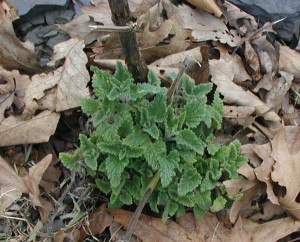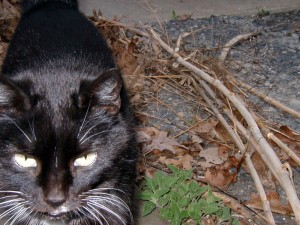The felines will be happy that the catnip keeps coming back. I don’t know what drives them crazy about catnip, but we do know that they really enjoy it. The outdoor cats will come by to roll around on and near the catnip plants and to take a nibble. The indoor cat demands a fresh sprig now and then. After a playful romp it’s nap time.
A few years back we sprinkled some catnip seed — from some flowering tops we harvested and allowed to dry — along the front of the house, next to the driveway and near the flagstone walk. Since that day we have had catnip plants every year, much to the delight of our feline friends.
I am a little surprised how extensive the catnip colony is getting. From the original few plants that sprouted from seed, there is now a large group of plants. The root system probably keeps this set of plants coming back year after year, while allowing the mother plant to spread out. More plants are popping up right in the gravel driveway and between the flagstones. Some of them are pulled up, given away or harvested for the kitties, but it seems like we’ll always have a few plants around.
Here in Pennsylvania catnip grows wild along the roadsides. Once you can recognize the plant it’s easy to see that catnip is quite common. It’s growing really close to the ground right now, but if you wait until mid-summer then you’ll be able to see the 3 feet tall plants more easily. When the catnip blooms, its white blossoms are easy to spot along a country road.

Leaves of catnip are soft, almost fuzzy to the feel while other mints don’t feel quite as downy. The scalloped edges of the triangle-like catnip leaves are distinctive.

If you’re unsure whether you’ve got another member of the mint family or catnip, just rub a leaf and smell it. The odor should tell you which plant you have found. If you can’t smell, just give it to a cat. They will wrinkle up their noses if it’s a different member of the mint family!

Now, what good ‘ole country girl doesn’t have a cat or two to play mouse-catcher?
![Reblog this post [with Zemanta]](http://img.zemanta.com/reblog_e.png?x-id=6c90decb-767c-4a27-b002-346cc3ce8bc1)